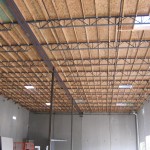Panelized Roof Dangers for Firefighters
By Christopher J. Naum, SFPE on Jul 09, 2011 with Comments 0
Panelized roof dangers for firefighters
Clark County, Nevada, Firefighter Colin Kelley discusses the construction and precautions firefighters should take when working on buildings with panelized roofs.
FlashoverTV is powered by FireRescue1.com
 Panelized wood roofs have been in use for more than 40 years west of the Mississippi, where wood has always been plentiful, but the roofing system is new to regions east of the mighty river and in Canada, where steel construction has always been dominant.
Panelized wood roofs have been in use for more than 40 years west of the Mississippi, where wood has always been plentiful, but the roofing system is new to regions east of the mighty river and in Canada, where steel construction has always been dominant.
Panelized wood roofs consist of structural wood panels attached to 2×4 or 2×6 dimension lumber sub-purlins or “stiffeners,” typically spaced 24 inches on center. The stiffeners are attached to secondary wood framing members, referred to as purlins. This work is done on ground level, and then the entire pre-framed panelized unit is lifted into position on the roof. Once on the roof, only one or two workers are usually needed to complete the assembly sequence.
Panelized wood roof systems consist of two common types: an all-wood system and a hybrid system consisting of long-span steel framing with a panelized wood roof deck. Both types are most commonly used with tilt-up concrete structures (and in some cases reinforced masonry walls) and are particularly suited to buildings with low-slope roofs, such as warehouses and big box retail outlets.
Excerpt from: http://www.bdcnetwork.com/article/3-steps-better-understanding-panelized-wood-roof-systems
1. Panelized wood roof system types
The all-wood roof system is anchored by long-span glued laminated timber framing. This system requires the purlins to be attached to the primary glulam beams using pre-engineered metal hangers. The free edge of the wood decking for each panelized unit is nailed to the framing edge of the previously placed unit. Pre-framed panel ends attach to the main glulam beams to complete the assembly. The pre-framed roof sections speed the erection process and add strength, dimensional stability, and high diaphragm capacity to the roof.
The hybrid panelized roof system combines panelized wood components connected to open web steel joists. The entire panelized unit is assembled on the ground and then lifted into position at the roof level, where the steel joists are welded or bolted to primary steel trusses. The free edge of the wood decking for each panelized unit is nailed to the framing edge of the previously placed unit. The pre-framed panel ends attach to the main steel trusses to complete the assembly.
2. Panelized wood roof components
Structural panels. APA-rated sheathing or APA-rated structural 1 sheathing is recommended for structural decking. The sheathing is typically plywood or oriented strand board (OSB), which comes in varying thicknesses and span ratings. OSB panels are manufactured in mats in sizes up to 8×24 feet; larger sizes are sometimes possible. These large dimension panels reduce perimeter fastening and speed construction.
The panels are installed with their long dimension parallel to stiffeners that support panel edges. The wood sheathing acts as a diaphragm element that both resists and transfers lateral loads from wind or earthquakes. Panel thickness and fastening schedules are determined by gravity loads, required shear load capacity, and the wind uplift resistance needed.
Glulam beams. The main glulam beams are often designed as cantilevered systems to optimize structural performance. Both single- and double-cantilevered beams can be used depending on bay spacings and building geometry. Cantilevered beams are specified as balanced lay-up combinations, such as a 24F-V8 Douglas-fir or a 24F-V5 southern pine.
Simple-span glulam girders, spanning column-to-column, in 30- to 60-foot lengths, is another popular design. Unbalanced combinations, such as 24F-V4 Douglas-fir or 24F-V3 southern pine, can also be specified. Simple-span girders are recommended for their ease of installation and their ability to be used with seismic connectors.
Purlins in all-wood roofing system. The secondary wood framing members, or purlins, are placed eight feet on center. These purlins have many forms depending on the spacing between the main glulam beam lines and designer/owner preference, but the most common is narrow resawn glulam beams that are 2½ inches wide with depths of 18 to 27 inches or greater.
Prefabricated lightweight wood I-joists are an economical purlin alternative for glulam beam spacings of approximately 40 feet or less or for relatively light roof design loads. I-joists can have depths up to 30 inches, depending on the span and loading conditions. I-joists also make it easier to cut holes in the webs for mechanical ductwork, wiring, and sprinkler lines.
Another purlin alternative is a glulam truss composed of glulam chords and webs interconnected with heavy metal gusset nail plates. When spaced eight feet on center, these trusses allow designers to use larger column grid spacings between the main glulam beams. Pre-framed panelized sections of up to 72 feet long are possible using glulam truss purlins, which enables contractors to erect roof units larger than 500 sf in one lifting sequence.
Steel joists. Steel joists used in the hybrid panelized system are typically placed eight feet on center. Because steel joists can span long distances, the panelized units can be prefabricated in lengths up to 72 feet—or in some cases even longer—to enable contractors to erect roof units larger than 500 sf in one lifting sequence.
Connectors. The panelized roof system is connected to the walls through the use of wood or steel ledgers, and virtually all connectors used in panelized roof systems are available off-the-shelf, and range from the 2×4 or 2×6 stiffener hangers to the more complex cantilever hinge connectors for the main glulam beam lines. Additional tie plates and straps may be required depending on lateral load design requirements.
Filed Under: Anatomy of Buildings • Structural Systems • Training Division • Videos























